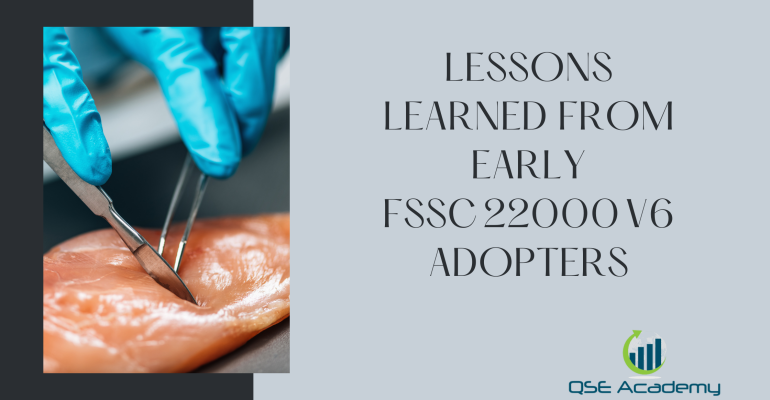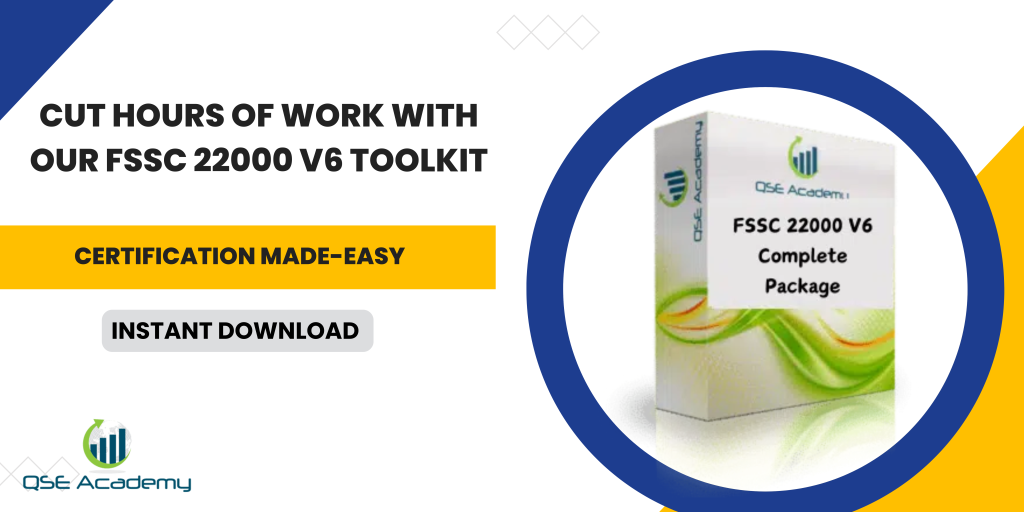Lessons Learned from Early FSSC 22000 V6 Adopters
What Early Adopters Taught Us About FSSC 22000 V6
When the FSSC 22000 V6 scheme rolled out, many organizations rushed to prepare. Some transitioned early, hoping to get ahead of the curve — and in doing so, they’ve given the rest of us valuable insight into what works (and what doesn’t).
In my experience supporting several early adopters through their V6 transition audits, one thing became clear: success didn’t come from having perfect documentation — it came from understanding intent, planning early, and closing small gaps before they became big findings.
This article shares those lessons — straight from real audit rooms and implementation projects — so your transition to FSSC 22000 V6 is smoother, faster, and more predictable.
Why Learning from Early Adopters Matters
Standards evolve, but the reality check comes only when audits start. Early FSSC 22000 V6 adopters were the first to face auditor interpretations, new documentation demands, and practical implementation challenges.
By studying their experiences, you can skip the trial-and-error phase and move straight to what actually works.
Here’s what I’ve noticed: facilities that observed and applied early lessons made their own transitions at least 30% faster and avoided most of the common non-conformities.
Pro Tip: Treat early adopter findings like a free preview of your own audit. They show you exactly where to focus your preparation.
Common Mistake: Ignoring feedback from early adopters and relying solely on the text of the standard — real audit behavior always adds nuance that the document doesn’t show.
 Lesson 1: Food Safety Culture Is Measured, Not Declared
Lesson 1: Food Safety Culture Is Measured, Not Declared
Many organizations thought a policy or a one-time meeting would check the “culture” box. Auditors quickly disagreed.
Early adopters learned that culture is about evidence, not statements. They needed measurable indicators — survey participation, internal communication metrics, or employee engagement trends — to prove commitment.
Example: One dairy processor started tracking quarterly surveys and staff feedback in their management reviews. That single change turned a potential finding into a strength during their audit.
Pro Tip: Build your culture metrics early. You’ll need several months of data to show improvement, not just intent.
Pitfall: Relying on anecdotes like “everyone knows the policy.” Auditors expect tangible proof that the food safety mindset is active, measurable, and reviewed.
Lesson 2: Environmental Monitoring Programs Need More Than Swabs
FSSC 22000 V6 made EMP mandatory for most food categories — and it quickly became one of the top non-conformity areas.
Early adopters realized EMP wasn’t just about taking swabs; it required a full program — with defined sampling sites, trending, data analysis, and corrective-action tracking.
Example: A frozen-food facility passed their retest after adding data trending and management review discussions into their EMP. Initially, their records showed results, but no evidence of trend evaluation or improvement actions.
Pro Tip: Think of EMP as continuous improvement. Data should tell a story — how clean your environment is getting over time.
Common Mistake: Treating EMP as a lab requirement rather than an operational monitoring tool that connects hygiene, maintenance, and sanitation performance.
Lesson 3: Additional Requirements Became the Game-Changer
Many early adopters underestimated the Additional Requirements section. They skimmed through it and missed major updates to allergen control, equipment management, and environmental responsibility.
Example: A packaging manufacturer received a major non-conformity because their allergen-cleaning validation wasn’t documented, even though their PRP procedure mentioned it.
Pro Tip: Review each Additional Requirement as if it’s a new clause. Auditors under V6 are giving them full attention — especially allergen, EMP, and environmental impact controls.
Common Mistake: Updating ISO 22000 documents but leaving the FSSC-specific Additional Requirements untouched.
Lesson 4: Internal Audit Programs Needed a Reset
Early adopters found that their internal audits weren’t ready for V6. Many reused their V5.1 checklists — and missed entire sections like food safety culture and EMP verification.
Example: A confectionery company conducted a dedicated “V6 mock audit” using a checklist built only for new and revised clauses. They identified eight potential findings and corrected them before their actual transition audit — zero majors, one minor.
Pro Tip: Create a transition-focused internal audit plan. Cover all new clauses, additional requirements, and PRP updates before your certification body arrives.
Common Mistake: Assigning auditors who haven’t been trained on V6 expectations. Auditor competence was another hot topic in early transitions.
Lesson 5: Documentation Control Had to Evolve
Early adopters struggled most with documentation management. The volume of updates — new PRPs, culture metrics, revised EMPs — quickly overwhelmed manual systems.
Example: One global food group solved this by moving to a centralized document-control platform. Each clause had its own version-controlled folder, and auditors could instantly trace revisions.
Pro Tip: Separate your V5.1 and V6 records. Mixing them creates confusion and invites audit findings.
Common Mistake: Having two versions of the same procedure floating around. Even small inconsistencies became findings during transition audits.
Lesson 6: Auditor Focus Shifted to “Show Me It Works”
Under FSSC 22000 V6, auditors shifted their approach. They weren’t satisfied with paperwork alone — they wanted proof of effectiveness.
Early adopters faced more interviews, walkarounds, and on-the-floor verification. Auditors asked operators how they applied procedures and what actions they took after EMP or culture reviews.
Example: In one beverage plant, auditors interviewed line workers about food defense. The team’s confident responses earned commendation in the final report.
Pro Tip: Train your people, not just your paperwork. A confident operator explaining their process is more convincing than a perfect SOP.
Lesson 7: Transition Planning Was the Deciding Factor
The best-performing companies had one thing in common — a structured transition roadmap.
They didn’t scramble. They conducted a gap analysis, updated PRPs, trained auditors, and scheduled mock audits months before certification.
Example: A mid-sized frozen-meal producer completed their entire transition in 10 weeks using a simple project plan with milestones tied to the FSSC V6 clauses.
Pro Tip: Assign a single transition lead with cross-functional authority. Weekly reviews make accountability easier and momentum faster.
Common Mistake: Treating the transition as an “administrative update.” The most successful transitions treated it like a full system improvement project.
FAQs
Q1. How long did early adopters take to complete the FSSC 22000 V6 transition?
Most needed 8–12 weeks, depending on company size, scope, and readiness of their documentation.
Q2. What were the most common audit findings?
Lack of measurable food safety culture data, incomplete EMP trending, and uncontrolled document revisions.
Q3. How can I use these lessons in my own transition?
Start with a gap analysis. Use early adopters’ experiences as your benchmark — prioritize EMP, culture, and additional requirements.
Conclusion: The Advantage of Learning Early
The first wave of FSSC 22000 V6 transitions proved something important — this version isn’t harder; it’s simply more evidence-driven.
Facilities that embraced data, training, and early planning succeeded with fewer non-conformities and smoother audits.
After guiding dozens of companies through their transitions, I can say this confidently: learn from those who’ve gone first. Their experience is your shortcut to success.
If you’re ready to build your transition roadmap, download QSE Academy’s “FSSC 22000 V6 Transition Lessons” Checklist or book a quick consultation to review your current audit readiness.
Melissa Lavaro is a seasoned ISO consultant and an enthusiastic advocate for quality management standards. With a rich experience in conducting audits and providing consultancy services, Melissa specializes in helping organizations implement and adapt to ISO standards. Her passion for quality management is evident in her hands-on approach and deep understanding of the regulatory frameworks. Melissa’s expertise and energetic commitment make her a sought-after consultant, dedicated to elevating organizational compliance and performance through practical, insightful guidance.








